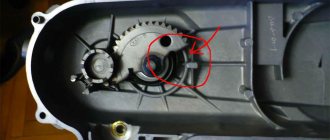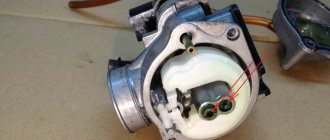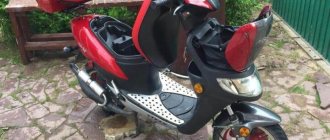In our region, winters can be quite harsh, and riding scooters becomes impossible. Therefore, scooter riders should worry about the wintering of their horses and create favorable conditions for the moped so that it does not need repairs when spring comes. Preparing a scooter for winter storage is a rather troublesome and responsible task. However, if all the rules and recommendations that we will consider in this material are followed, in the spring you will be able to start your vehicle the first time without carrying out any repair work. Vehicles quite often need the latter after a long winter hibernation.
How to prepare a scooter for winter
Preparing a moped for winter is a very important task. If you follow all the rules set out below, the engine of your scooter will start without problems in the spring, and all its components and parts will be in the same condition as before hibernation.
So, the rules for preserving and storing a scooter in winter .
- Washing a scooter is a mandatory process in preparing a moped for winter. You need to thoroughly wash all components of the scooter with a Karcher, paying special attention to hard-to-reach places where a lot of dirt remains. If you don’t know how to properly wash a moped, then our article How to wash a scooter will help with this
- Polishing the plastic and plastic parts of the scooter with wax or a special product - polish. A car spray is quite suitable for servicing these surfaces.
- Treat all external metal parts of the scooter with a special anti-corrosion agent. WD-40 aerosol is suitable for this procedure.
- Also treat the rubber parts of the moped (tires, variator belt, etc.) with tire cleaner or silicone spray. This is done so that the rubber does not crack at sub-zero temperatures in winter.
- Lubricate the accelerator and drum brake cables with oil using a syringe to prevent the cable threads from breaking after winter.
- To avoid rusting the shock absorber fork and, as a result, poor performance, you need to treat the feathers with regular oil.
- Reduce the pressure in the scooter tires by 40-50% of the recommended value. No load on the tires is allowed, and the moped must be mounted on the center stand in winter. Recommended scooter tire pressure depending on wheel size can be found here
- The fuel tank should be filled to capacity. This is also done to prevent corrosion. Fuel should be of high quality (see the article How to check the quality of gasoline). If you nevertheless neglected this rule when storing your scooter for the winter and your fuel tank has succumbed to corrosion, then the article Cleaning the gas tank from rust is for you. However, some scooters are equipped with a plastic tank and there can be no corrosion here. Another reason to fill the tank full of fuel in preparation for winter is to start the engine in the spring (if there is no gas in the tank for the whole winter, this can be difficult)
- Replace the transmission oil in the scooter gearbox, and if there is a chain, lubricate it with special lubricant
- Plug the exhaust pipe with a specially prepared cork (a champagne cork is suitable for some scooter models), a rag or a plastic bag. Such actions are carried out to prevent the formation of moisture in the exhaust tract.
Do I need to prepare gasoline-powered garden equipment for winter?
This question is controversial in many aspects. A considerable number of gardeners are of the opinion that branded garden equipment, when using high-quality fuels and lubricants, does not require preparation for winter storage at all. And in the spring, after topping up and pumping up gasoline or the fuel mixture, it will continue to operate without any problems.
At the same time, the storage conditions for garden equipment are completely different for everyone. Some people can afford to store it in a warm room, while for others it will lie all winter in a damp and frosty barn. And the concept of “high-quality fuels and lubricants” is quite vague in our country.
My opinion is this: if you can avoid moisture (dew) when storing a gasoline engine, then preserving cylinders and elements of garden equipment for the winter is not necessary. It will be enough to simply drain and use up the remaining gasoline or fuel mixture. The appearance of moisture can be avoided in several ways: store the engine at room temperature, or ensure high-quality thermal insulation of the engine, for example, store it in a tight box lined with mineral wool on the inside.
Storing lawn mowers in winter – goals and objectives.
Proper storage of lawn mowers in winter consists of several preparatory stages. The main one: preparing the brush cutter engine for long-term storage in winter. It will prevent the rings from being pressed into the piston, and will eliminate the consequences of oil hardening and moisture condensation on the internal parts of the engine with subsequent corrosion.
Drain the gasoline or fuel mixture.
- We clean the gasoline spit from dirt.
- We drain the gasoline or fuel mixture from the garden equipment and screw on the gas tank cap. I do not recommend using the drained mixture as fuel for equipment in the future. Read how long you can store fuel mixture for two-stroke engines here.
- We start the lawn mower and wait until the remaining gasoline in the carburetor, primer and fuel line is exhausted at idle speed. There are few residues and the garden equipment will not work for a long time. Before stopping, the engine will slightly increase speed due to the leanness of the fuel mixture.
Preservation of brush cutters - treatment of engine cylinders.
- We remove the candle holder.
- We unscrew the candle. We check the gap and its general condition.
- Using a syringe, spray 2-2.5 ml of oil through the spark plug hole in the cylinder cavity, which is intended for making the fuel mixture for your garden equipment. You can use any anti-scale, anti-corrosion agent, ideally a specialized product for the internal preservation of motorcycle engines.
- Using a manual starter with the ignition off, turn the piston several times.
- We twist the candle.
- We put on a candlestick.
Attention. If you accidentally overfilled the oil, and in the spring your garden equipment does not want to start
First of all, unscrew and degrease the spark plug.
Preservation of lawn mowers – treatment of the carburetor and cleaning of the air filter.
- We remove the air filter cover and the filter itself with a metal mesh, if such is provided for in the design of the garden equipment.
- Open the throttle valve.
- Inject anti-corrosion agent into the carburetor.
- We wash and dry the air filter. We install it in place.
Preparing the cutting knife of garden equipment for long-term storage.
- We remove the knife.
- We clean it of dirt.
- We treat it and the seats with an anti-corrosion agent. To save money, you can use any inexpensive machine oil, incl. and working off.
Preparing the mowing reel with fishing line for winter storage.
- Remove the mowing head from the garden equipment.
- We disassemble and clean from remaining grass and dirt.
- We unwind the line from the reel.
- We store the fishing line in a damp place to prevent it from drying out and becoming brittle. For example, wrap it in a bag with added water.
Advice. If in the spring the mowing line still becomes rough and brittle, place it in water for several hours. It will partially restore its properties.
If you have time, do not put off lubricating the gearbox until the “future”.
Proper storage of the lawn mower during long periods of downtime, and even more so in winter, preservation of its engine and cutting tools will ensure its uninterrupted operation next season. In addition, they will save a lot of nerves and money, of which, as you know, there is never too much.
- 5
- 4
- 3
- 2
- 1
(0 votes, average: 0 out of 5)
Preserving the engine for the winter
A separate point worth highlighting is the question of how to preserve the engine for the winter . I don’t think it’s worth explaining why in a separate paragraph: the engine is the most important component of a scooter.
As you have already noticed in this publication, we provide information on the ideal preservation of a scooter for the winter. Such preparation of a moped for winter requires physical, material, and some moral costs (however, as with any maintenance, repair or tuning of a moped). But the result will not be long in coming in the spring :).
Preserving the engine for the winter begins by treating the crankshaft journals with a special aerosol lubricant. This will prevent the engine shaft from seizing due to rust on the journals.
If there is carbon deposits on the piston and valves, then you should disassemble the CPG and clean these elements. Also, when preparing the engine for winter, it is recommended to add a fuel system cleaner to the fuel, as well as purchase and apply a carbon remover and drive approximately 50 km. Removing carbon deposits should be taken seriously, as its parts can lead to mechanical damage to the cylinder-piston group.
To properly preserve the engine, it is recommended to replace the engine oil with new one. Under no circumstances should the engine crankcase be left empty (corrosion is a risk).
To protect the internal surfaces of the CPG from corrosion, special aerosols must be used. For 4t engines, this aerosol is launched through the spark plug hole, and then the crankshaft is cranked with a kick starter or starter for 5-10 s. For 2t scooters, the spray is first sprayed directly into the carburetor of a running engine for 15-20 s. Then the engine is turned off and the product is launched through the spark plug hole in the same way as with four-stroke engines. Instead of an aerosol, you can pour 3-5 cubic meters into the candle hole with a syringe. see engine oil and crank the starter a couple of times. This way we will lubricate the walls of the cylinder and piston.
General rules for storing gasoline equipment
There are several general rules for preparing gasoline equipment for winter storage, regardless of their performance and technical design, which may differ.
Common procedures include:
Unit operation cycle using a cleaning additive
This is necessary in order to clean the fuel system elements and the engine from deposits and carbon deposits that accumulate over the season of using the equipment. If you neglect this point, combustion products can become embedded and remain in the base of the fuel system forever.
Clean and shiny
Before preparing for conservation from the technical side, the equipment must be cleaned and washed. Organics and soil or sand destroy mechanisms and provoke oxidation.
Equipment with single-stroke engines. Preparation and canning
The first step in preparing the unit is draining the fuel. For this type of equipment, the fuel is an oil-fuel mixture. After two weeks of storage, it divides into layers and becomes unsuitable for engine operation.
To protect the internal walls of the cylinder, it is necessary to fill it with oil (the main thing is to remember to drain it before using the unit next season). This method will help protect the engine from corrosion. The cleaned carburetor should be coated with a special composition that resists corrosion.
How to prepare your battery for winter
If you want to start a scooter without problems after winter, then in addition to the above recommendations, you simply need to address the issue of preparing the battery for winter .
First check the density of the battery electrolyte, and fully charge the battery with a suitable charger. If the density of the electrolyte is less than normal, the battery case may crack and the liquid may leak out.
Where to store the battery in winter
Regardless of whether your battery is gel or lead, 6 Volts or 12 V, storing the battery in a cold garage in the winter is a very bad idea. The battery should only be stored in a warm room in winter. We found out whether it is necessary to remove the battery for the winter.
But besides removing the battery from the scooter, it also needs to be recharged at least once a month. To do this, you must first completely discharge the battery (this can be achieved by connecting a light bulb to the terminals) and then charge it with a current equal to 10% of the nominal one. For example, with a nominal capacity of 15 Ah, you need to charge the battery in winter with a current of 1.5 A for 10-12 hours.
JavaScript is disabled in your browser
As you know, most scooter riders operate their equipment only in the warm season, and in winter the scooter is laid up until the onset of spring. Unfortunately, it is not uncommon for a scooter that is fully operational in the fall to completely refuse to start after winter, or other problems appear with it. The reason for such troubles is improper preparation of the scooter for winter storage. Let's take a closer look at this issue.
You should begin preparing your scooter for winter storage by thoroughly washing it. After the scooter has dried, we recommend applying a special protective polish to the plastic elements. Also, coat all chrome parts with preservative lubricant. Treat unpainted metal parts with a moisture displacer, such as the well-known WD-40, to protect them from corrosion. Treat rubber parts with silicone spray.
Take care of your scooter tires. Treat your tires with silicone spray or polish them with silicone-based shoe polish. Reduce tire pressure to approximately 0.5 - 0.8 atmospheres. When storing, place the scooter on the center stand.
If the scooter is equipped with a plastic gas tank, then drain all the gasoline from the tank, start the engine, and let it run until all the remaining fuel in the carburetor and gas line is used up. If the tank is metal, then on the contrary it must be completely filled with fuel so that rust does not appear inside the tank. At the same time, it is advisable to add a fuel stabilizer to gasoline so that it does not lose its quality during the winter parking period. You can also, as in the case of a plastic tank, drain all the fuel and hang a small bag of silica gel inside the tank, which will absorb moisture inside the tank and prevent corrosion. The tank must be tightly closed.
Disconnect the scooter battery from the on-board network. You can remove only one terminal and leave the battery in place. To maintain battery performance, you must keep it charged. To do this, periodically, once a month, or at least once every two months, you need to recharge the battery using a charger with a small current. Please note that if the battery is severely discharged, its electrolyte may freeze at low temperatures, which will completely damage the battery. If the battery is fully charged and the density of the electrolyte in its banks is normal, then such a battery can withstand almost any frost. It is better to “winter” the battery in the cold rather than in a warm room, since at low temperatures all chemical processes inside the battery slow down, and the self-discharge process also slows down.
Take care to protect the “insides” of the engine from corrosion. Remove the spark plug, pour 20-30 ml of the engine oil you use to refuel the scooter into the spark plug hole, crank the crankshaft several times using the kickstarter so that the oil is distributed along the cylinder walls, then install the spark plug in place. Plug the exhaust pipe outlet with a piece of oiled cloth or paper. Use the same method to seal the air filter inlet. All this will prevent air from entering the engine and protect it from corrosion.
If the scooter is equipped with a motor with a liquid cooling system, then make sure that the system is filled with antifreeze and not ordinary water, otherwise at low temperatures the motor may simply “split,” that is, its body will crack.
Storing a scooter in a warm garage or outside in winter
When storing a moped for the winter in a warm, non-humid room, it is not necessary to carry out all of the above points for preparing and preserving the scooter for the winter. For example, you don’t have to remove the battery , but just disconnect the negative terminal from the scooter and recharge it once a month. We also recommend starting the engine 3-4 times during the winter period and letting it run for 10-20 minutes.
If you do not have the opportunity to leave your horse either in a warm room or in a cold garage, and you are going to store your scooter outside in the winter, then cover it tightly with a tarpaulin cover. Tarpaulin does not allow moisture to pass through, but air does. You should not cover the moped with a film or material that does not allow steam to pass through - condensation will form from the inside and will result in rusting of the metal parts. Of course, everything stated above regarding the proper preparation of the battery, engine and scooter in general for winter when storing the moped in this way must be carried out with double responsibility. But you must understand that it is still not recommended to store a moped in winter in this way.
Following these simple rules for preserving and preparing your scooter for winter will help you enjoy riding a moped during the first warm weather in the spring, rather than having to deal with scooter repairs. Good luck!
Shustrik: a unique snow scooter
This is a one-of-a-kind scooter designed specifically for winter use. The manufacturer has thought through the design of the vehicle down to the smallest detail, ensuring the highest functionality. The wide cast ski is stable and comfortable to stand on with both feet. At the back of the platform there is a grooved block for the foot, which allows you to put one foot on the ski and actively push off with the other without losing balance. The steering column is made in the form of a pyramid, this allows you to increase the speed of the scooter. The vehicle is easy to drive; just lean in the right direction when turning.
READ ALSO
19 best motorcycles
Pros:
- rides well on compacted roads, crust and loose snow;
- the scooter handle is pressed tightly against the platform, providing compact storage;
- made of frost-resistant plastic, does not crack;
- comfortable narrow handles that do not block the view;
- affordable price: 740 rubles;
- wide age range: for children from 5 years to adults (50 kg).
Minuses:
for winter use only.
Materials and tools you will need to preserve your bike
Before you start preserving, you will have to do some shopping. This cannot be avoided even if the motorcycle is stored in a warm garage, because the bike will have to sit for at least 3 months, while its parts may simply become corroded due to moisture in the air. The main purpose of conservation is to eliminate moisture and dirt, as well as to preserve internal parts from corrosion.
For this you will need:
- special shampoo for washing vehicles;
- Silicone Grease;
- spray for metal surfaces WD-40 or any other equivalent;
- pump;
- chain lubricant;
- new motor oil;
- rags or any dense material for the plug;
- gasoline by tank volume;
- waterproof cover;
- wax polish or simple lubricant;
- polish for plastic.
It is necessary to choose only high-quality materials from well-known manufacturers. The packaging of lubricants must be preserved, because if the product was left open for a long time, its consistency and physical and chemical properties could change.
As a result, when low-quality or damaged materials are applied, they are not able to fully protect parts from corrosion.
Restoring working condition
At the end of winter, the battery should be prepared for use. First, the solution poured in the fall is drained from it. It is worth noting that this must be done slowly, at the same pace at which it was poured. Draining the acid takes about 20 minutes. Then the device is washed from the inside several times with distilled water. It is advisable to leave it in the battery jars for 10 minutes to get the best effect. When the battery is thoroughly washed, electrolyte is poured into it and left for 40 minutes. This is necessary to check that its density remains unchanged. Otherwise, you will need to adjust this indicator based on the marks.
After completing these steps, the device is completely ready for use and can be installed in a vehicle. The terminals are connected in the reverse order compared to the process of removing the battery.
If you follow the established rules for storing the battery and use it correctly, it will last for a very long time.
The battery is required to start the vehicle's engine. Its serviceability makes the mechanism stable. Vehicle downtime, which often occurs in winter, does not have the best effect on the condition of the battery. Storage rules during the cold season will help maintain its performance. Contents Types of car batteries Photo gallery of batteries Is winter storage required? Preparatory work Dry battery With filled electrolyte Gel For motorcycle Rules […]
Where is the best place to store a motorcycle?
Friends will say - a garage (yup, unheated), the mother-in-law will suggest a shed in the country, the wife will advise sending the bike to a paid parking lot, but all this is not the same. The best place to store a motorcycle in winter is a warm Attic storage area. Why are we so sure of this? Look at the benefits of winter motorcycle storage in a warm warehouse:
- constant temperature of +18 degrees Celsius at any time of the year;
- ventilation and cleaning consistently three times a week;
- complete security - 24-hour security and video surveillance around the entire perimeter of the warehouse without blind spots;
- delivery service.
Attic movers will come straight to your home and take your motorcycle to the warehouse, where it will be safely stored all winter. When the season comes, we will bring it back to anywhere in Moscow. All motorcycles in the Attic are stored in a separate area on pallets - we keep them warm, dry and happy.











